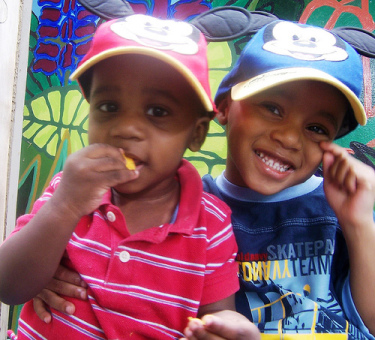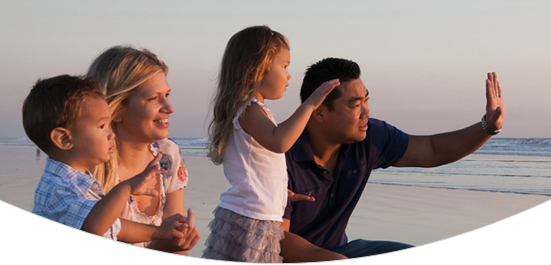
So the three initial steps in helping your toddler develop social intelligence are to help them:
- Notice what they want and express it without attacking others.
- Develop empathy for others.
- Trust that they will get their needs met so they can delay gratification for short periods of time (for instance, to take turns).
These three skills will help your toddler learn to manage their emotions, which is the foundation of all interpersonal relationships. This skill set will be more critical to your child's happiness in life than academic success, financial success, or any of our other conventional measures. In fact, emotional intelligence -- defined as the ability to manage one's own emotions and relate well with others -- will be a crucial factor throughout your child's life in his or her eventual academic and career success, probably more important than IQ.
So how do you get your toddler started learning social skills? Or at least stop him from clobbering the other kids in the playgroup?
1. Empathize, Empathize, Empathize.
Kids who receive a lot of empathy for their own feelings from the adults in their lives are the earliest to develop empathy for others, and research has shown that empathy for others is the cornerstone of successful interpersonal relationships.
2. Stay close during playgroups.
Many kids hit during social interactions because they get overwhelmed and they just don't know what else to do. If you're there, you can coach him on how to stick up for himself without hitting: "Yes, Ryan took your bucket....is that okay with you? No? You can say 'My Bucket!'" If your child knows you're there for backup, hitting won't become a habit.
3. Don't force toddlers to share.
It actually delays the development of sharing skills! Kids need to feel secure in their ownership before they can share. Instead, introduce the concept of taking turns.
“It’s Sophia’s turn to use the bucket. Then it will be your turn. I'll help you wait."
4. Let the child decide how long his turn lasts.
If kids think adults will snatch a toy away once the adult's random idea of "long enough" has passed, you're modeling grabbing, and the child usually becomes more possessive. If the child is free to use the toy for as long as he wants, he can fully enjoy it and then give it up with an open heart. When he's allowed to give the toy to the other child of his own volition, he enjoys that feeling of bestowing; that's the beginning of generosity. If the same child uses the same toy every single time, you can either buy a duplicate toy since it's such a crowd-pleaser, or alternate turns visit by visit.
For more on how to manage sharing, see this article: Teaching Kids To Share.
5. Help your child wait.
If your child has a meltdown waiting for her turn, it's an indicator that she's got some big feelings to let out and is using this handy opportunity. Kids often get rigid about possession in an attempt to shore up their fragile equilibrium--just like adults! Empathize: "It's hard to wait... You wish you could use the bucket now... You can handle this... I will help you wait" and hold her while she cries. You'll be amazed to see that after "showing" you those pent-up emotions, she probably won't even care about the toy she was crying for, and will happily move on.
6. Intervene to stop compulsive grabbing.
Sometimes when kids grab, the other child doesn't even care. So don't rush to intervene. Instead, observe. Maybe they're playing a game. Most of the time, you don't need to interfere unless one of the children is unhappy. And if one child IS unhappy, you can coach them to stick up for themselves: "You can tell him, 'I was still using that!'"
However, if one child is grabbing constantly, then you probably do need to intervene. Often kids will grab anything the other child has, then drop the toy and go on to the next one. This compulsive need to take what the other child has is an effort to stave off their own unhappy feelings. They need help with those feelings.
So summon up all your compassion, put your hand on the disputed toy and say "You want the truck?" Then look at the child using the truck. "Is that okay with you?" If it is, great. You don't have to be the arbiter of fairness.
If not, say "Cole's still using the truck. Trevon, you can ask him when he will be done so you can use it. Cole, will you give the truck to Trevon when you're done? Great, thanks! Trevon, let's find something else to do. Do you want to use the snowplow to make a road for the truck?"
He may well fall apart, especially if he was grabbing to hold himself together. Nurture him through the meltdown. Afterwards, he'll feel so much better, he won't need to grab.
7. Teach assertiveness.
If your child often lets other kids take things from him and then seems unhappy, say
"You aren't ready to give that up, are you? You can say 'I'm still playing with this.'"
Practice acting this out at home with him, and demonstrate it with teddy bears. Until he develops the language skills, you'll need to be his "voice" when he plays with others.
8. Instead of praising sharing in the abstract, help her discover what's great about it.
Research shows that when we praise sharing kids do it more -- but only when we're watching! When we aren't watching, they actually do it less, because our praise doesn't give them any reason to share except that moment of attention from us. Instead, empower her to make the choice to share in the future by helping her notice how good her choice feels to her. We're communal creatures. Research shows that when our actions make someone else happy, we feel good.
"Look how happy Michael is that he gets a turn with your train."
When you adopt the policy of letting kids have a turn for as long as they want, they proudly give the coveted item to the other child at the end of their turn. They get to experience how wonderful it feels to give. So letting kids control their turns is the best way to promote sharing and generosity.
9. Before friends come over, toddlers should have a chance to put away their most special toys
...if they don’t want anyone else to play with them. Use this ritual as an opportunity to explain that the visiting child will of course expect to play with Junior’s other toys, just as Junior plays with his friends’ toys at their houses.
10. Set clear limits on physical aggression.
"You can tell us and show us how mad you are without hurting. Come, let's tell Henry how mad you are; I'll help you. You can yell NO and you can stomp your foot as hard as you want. You can yell MOM! and I will always help.”
Kids are entitled to their feelings, which have a way of just showing up in human beings, like our arms and legs. But all humans, even little ones, are responsible for what they do with their arms and legs -- and feelings. Our job as parents is to teach them healthy self-management techniques without being punitive, which always makes kids more physically aggressive.
11. It’s never too early to give children language for their feelings.
Labeling any emotion your toddler expresses helps their brain shift toward processing the emotion verbally instead of physically.
- “That big dog’s bark is scary, right? You’re safe here with me. The dog can't get over the fence.”
- “That's frustrating! You worked hard on your tower -- and it fell down!”
The exception to this is when children are in the throes of big emotion, when too many words can take them out of their heart and into their heads. At those times, just reassure your child he's safe, and save the words for later.
And remember that "labeling" emotions is always secondary to empathy. Your goal is to help your child feel understood, not analyzed.
12. Remember that underneath anger is usually hurt or fear.
Acknowledging those feelings is always more effective to diffuse anger than simply labeling the anger, which just seems to reinforce it. “You’re mad at Jimmy. It hurts that he won't play with you right now.”
13. Remember that "parallel play" is common for toddlers.
Don't worry if your toddler doesn't really seem to have "friends" or to play with other kids. Toddlers don't yet know how to "play with" each other. You can expect them to play next to each other without a lot of interaction. This is a foundation for becoming comfortable engaging with each other; in fact, it is how most toddlers feel engaged.
14. Begin introducing the concept of noticing how other people feel as early as you can.
- "Look at William. He's crying. I think he's sad about this.”
- “That little girl is sure mad. I wonder why?"
- "Imani hurt herself. I wonder if we can do anything to help her feel better?"
15. Stay Calm.
Research shows that one of the most important things parents can do to help kids learn to manage their emotions is to stay calm themselves. Kids need to experience their parents as a "holding environment" -- a safe harbor in the storm of their turbulent feelings. If you can stay calm yourself, and soothe your child, she will eventually learn to soothe herself, which is the first step in learning to manage her feelings.
16. Remember they're kids.
Just because James bites a playmate doesn't mean he'll be a thug. It's important not to permit bad behavior toward others, but that doesn't mean you don't offer understanding -- and the confidence that your child will learn. "All kids get mad at their friends sometimes. It will be easier, as you get older, to remember how to control yourself when you get mad, so you can work things out." Kids need to hear from you that they aren't bad people, just little.
What about sibling sharing?
Of course, all of this applies to siblings. But siblings have their own intense dynamics of competition because they have to share more than toys -- they have to share you! The most important intervention for siblings is prevention, in the form of one-on-one time with you, the parent. For more info on siblings, see the sibling section of this website and my book Peaceful Parent, Happy Siblings: How To Stop the Fighting and Raise Friends for Life.





